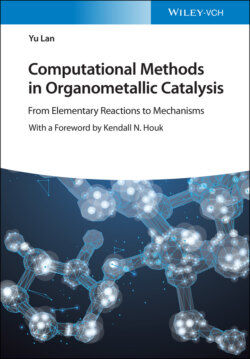Читать книгу Computational Methods in Organometallic Catalysis - Yu Lan - Страница 37
2.5.2 How to Choose a Density Functional
ОглавлениеStrictly, this paragraph may be the least serious part in this book, because the selection of a functional in computational organometallic chemistry has many other reasons, even might be that I like this functional. If there must be a way, the selection of density functional can be based on the targeted benchmark results because of the lack of clear physical meaning leading to the inestimable error. However, there are often insufficient data for that in a specific organometallic system. Therefore, it is rather hard to choose a density functional for computational organometallic chemistry.
Until now, B3LYP functional has always been the preferred functional for theoretical study of reaction mechanism, although it has been proposed for more than 20 years. There are hundreds of density functionals, many of which would perform better than B3LYP in their own field of expertise. However, very few of them have more comprehensive performance than B3LYP, which leads to popularity of that functional. There are two main weaknesses in B3LYP: (i) disregard of dispersion interaction and (ii) the bad performance on charge transfer and Rydberg excitations. The first problem can be completely modified by DFT‐D3 correction without additional computing time. The second one can be solved by the variant CAM‐B3LYP functional. These amendments continue to extend the service life of B3LYP functional.
From a large number of calculation results, M06‐2X, which is a Minnesota series functional proposed by Truhlar in 2007, proved to be one of the best alternative functionals of B3LYP. In this functional, dispersion effect is introduced in its fitting parameters, which reveals good weak interactions. The 54% HF exchange component leads to a better performance on the calculation of charge transfer and Rydberg excitation. The shortcoming is that Minnesota series functionals require much higher accuracy of DFT integration grid than B3LYP. It could be solved by improvement of that; however, it will obviously be more time consuming. Moreover, M06‐2X functional is parameterized for the main group elements; therefore, it is unsuited for the calculation of transition metal involved system. As an alternative, M06‐L functional can be used in this case. It is noteworthy that MN15, also proposed by Truhlar in 2016, achieves a good balance between main group and transition metal elements in computational study.
The ωB97XD functional is another alternative of B3LYP, which is proposed by Head‐Gordon group in 2008 [94, 95]. This functional included empirical dispersion at DFT‐D2 level, which gives a good accuracy of weak interaction. Moreover, the introduction of long‐range correction into ωB97XD gives a good result in the calculation of charge transfer and Rydberg excitation. The time consumed for ωB97XD is also significantly higher than that of B3LYP.
Based on the author's experience, it is better to use hybrid‐GGA or hybrid‐meta‐GGA functionals involving dispersion correction on the geometry and thermodynamics calculation of organometallic system.
